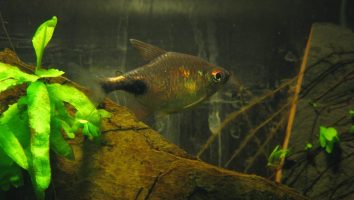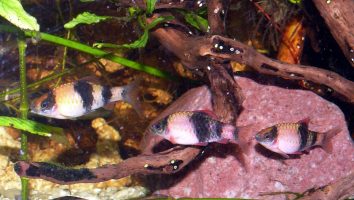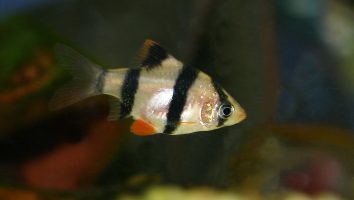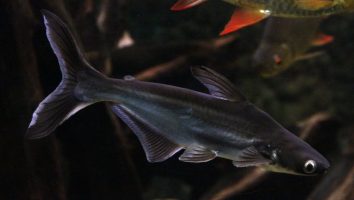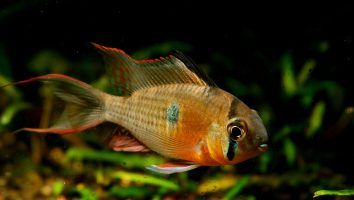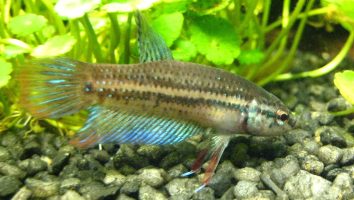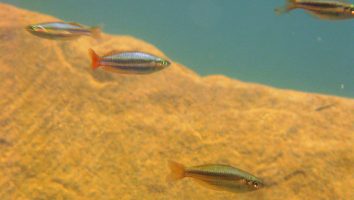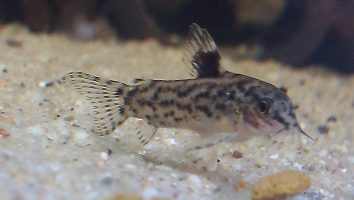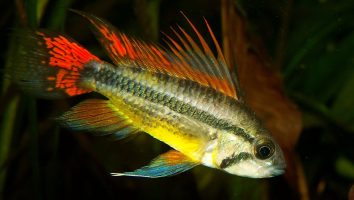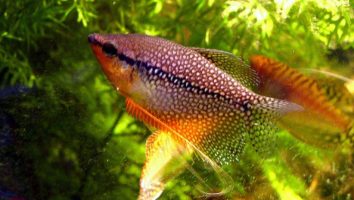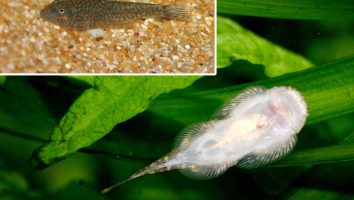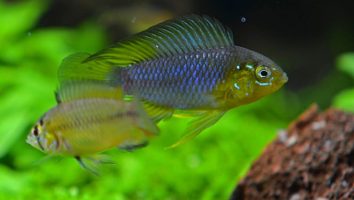The freshwater blenny is a unique and interesting fish that is perfect for the nano aquarium.
They are peaceful by nature and have a very calm demeanor which makes them a great addition to any community tank.
What’s more, they are very easy to care for and are very tolerant of a wide range of water parameters.
In this guide, we will teach you everything you need to know about freshwater blenny care. You’ll learn about their diet, tank mates, lifespan, and more!
Table of contents
Species overview
The freshwater blenny (scientific name: Salarias fasciatus) is a type of fish that’s native to certain areas of Southeast Asia. They are most commonly found in Indonesia, Malaysia, and Thailand.
These fish prefer to live in brackish waters, which is a mix of salt and freshwater. This is something that you’ll need to keep in mind if you’re thinking about keeping them in your aquarium.
They are relatively small fish, only growing to be about 3 inches in length. This makes them a good choice for smaller aquariums.
Freshwater blennies are relatively peaceful fish, although they can be a bit nippy. They are also known to be good jumpers, so you’ll need to make sure that your aquarium has a tight-fitting lid.
Appearance
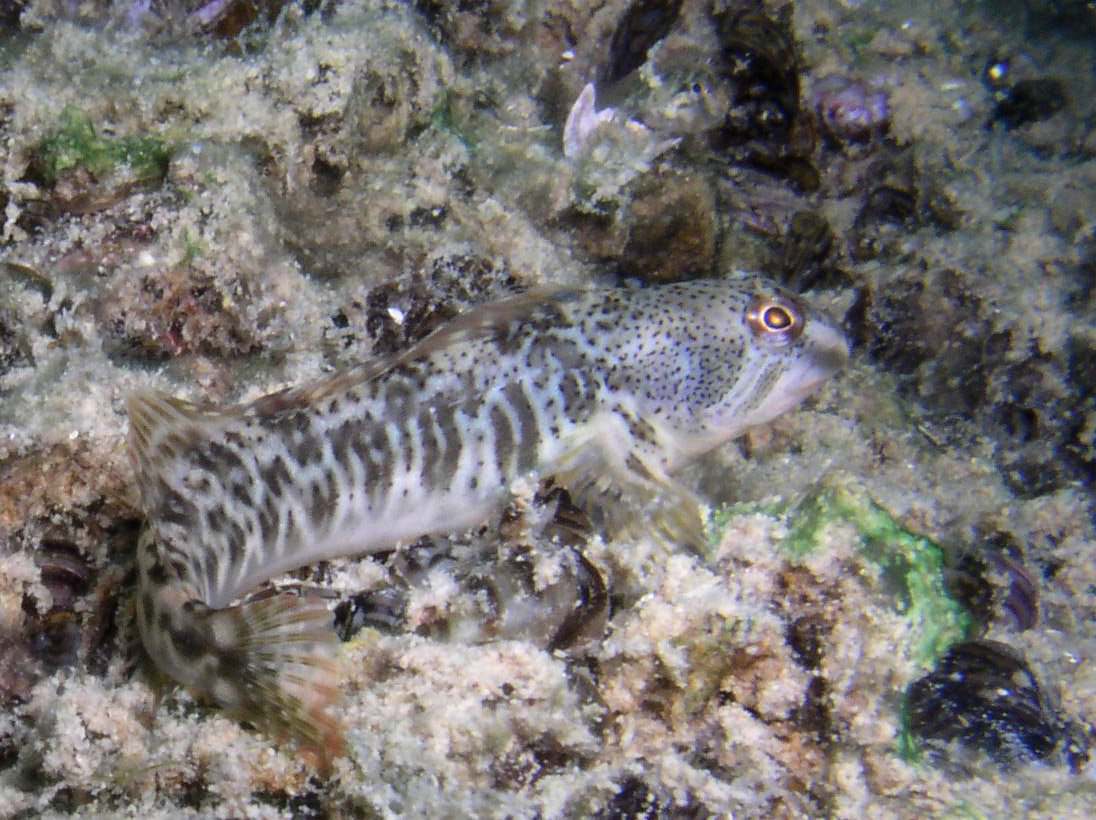
The Freshwater blenny is a small, brownish-red fish with a long, slender body. They have a small head with large eyes, and a small mouth that is often hidden beneath their protruding snout.
The dorsal fin is located towards the back of their body and is relatively small. The anal fin is located towards the back of their body and is slightly larger than the dorsal fin. The caudal fin is forked and located at the very back of the fish.
The pectoral fins are located towards the front of their body and are relatively small. The pelvic fins are located towards the front of their body and are slightly larger than the pectoral fins.
Freshwater blennies have smooth, scaleless skin and are covered in mucus. This mucus helps to protect them from parasites and pathogens.
Lifespan
The lifespan of a freshwater blenny is typically 5 to 8 years. However, some captive specimens have been known to live up to 10 years with proper care.
As with all fish, there are a number of factors that can impact the lifespan of a freshwater blenny. These include water quality, diet, and stress levels.
Size
The maximum size of a freshwater blenny is about 3 inches in length.
Tank
Tank Size
The recommended minimum tank size for freshwater blennies is 10 gallons. This is assuming you’re only keeping one fish and don’t plan on having any tank mates. If you want to keep a school of blennies or add other fish to the tank you’ll need at least 20 gallons.
Water Parameters
The freshwater blenny is a tropical fish that does best in warm water with a moderate pH. It’s also important to maintain high water quality and perform regular water changes to keep the blenny healthy.
- Water Temperature: 75 to 82 degrees Fahrenheit
- pH Levels: 7.0 to 8.5
- Water Hardness: 5 to 15 dGH
- Alkalinity Levels: 4 to 8 dKH
What To Put In Their Tank
The first thing you need to do is select the right type of substrate. These fish love to sift through sand and small rocks in search of food.
Aquarium gravel can work, but it’s not the ideal choice. We recommend using something like black sand or small pebbles instead.
The next thing you need to do is make sure there are plenty of places for your fish to hide. Blennies are timid fish that like to have a safe place to retreat to when they feel scared or threatened.
Caves, rockwork, and driftwood are all great choices. Just make sure there are plenty of nooks and crannies for them to explore. If you’re keeping more than one blenny in the same tank then you might need to provide even more hiding spots.
Plants are a personal preference, but we recommend avoiding them if possible. These fish love to nibble on vegetation, and they can quickly decimate a plant-based aquarium. If you must have plants in their habitat then go with something tough and fast-growing (like Java Fern).
Common Diseases
Freshwater blennies are known for being a hardy and disease-resistant fish. They’re not immune to illnesses, but they’re certainly not as susceptible as some other freshwater species.
The most common disease that affects freshwater blennies is ich. This is a parasite that can quickly spread and become quite serious if it’s not treated early on.
The most obvious sign of ich is the presence of white spots on the body of your fish. If you notice this, it’s important to take action immediately.
There are plenty of other potential diseases that can affect blennies, but they’re not nearly as common. Some other things to look out for include fungal infections, bacterial infections, and parasites.
As with any fish, the best way to keep your blenny healthy is by maintaining a clean and stable tank. This will go a long way in preventing disease and keeping your fish happy and healthy.
Behavior & Temperament
The freshwater blenny is a unique fish that is known for its interesting behavior and personality. These fish are relatively peaceful, but they can be a bit nippy towards tank mates that they don’t know. They are also known to be a bit aggressive towards their own species.
Freshwater blennies are very active fish. They are constantly swimming around the tank and exploring their surroundings. They are also known to be very curious. They will often approach humans and other animals that are near their tank to investigate them.
Freshwater blennies are also known to be very good jumpers. They have been known to jump out of tanks that are not properly covered. So, it is important to make sure that your tank is covered if you have one of these fish.
Overall, the freshwater blenny is a great addition to any aquarium. They are interesting fish to watch and can be a lot of fun.
Tank Mates
The freshwater blenny is a unique looking fish that does best in a community tank. These fish are peaceful and get along well with other fish, making them a great choice for beginners.
When choosing tank mates for a freshwater blenny, it’s important to select fish that occupy different areas of the tank. This will help reduce aggression and stress levels.
Here are some compatible freshwater blenny tank mates:
- Guppies
- Mollies
- Platies
- Swordtails
- Neon Tetras
- Danios
- Tetras
- Rasboras
- Clownfish
- Damselfish
Breeding
Breeding freshwater blennies is a bit more difficult than other fish species. They are not as prolific as, say, guppies, and the fry are very delicate. Still, it is possible to breed them in captivity with some patience and care.
The first step is to set up a breeding tank. It should be at least 20 gallons in size and well-filtered. You’ll also need to add some live plants and a few hiding places. Blennies like to have plenty of places to hide.
Next, you’ll need to sex your blennies. Males and females have different coloring. Males are usually more brightly colored, while females are a bit drabber. In addition, males tend to have longer fins.
Once you’ve sexed your blennies, it’s time to add them to the breeding tank. Add two females for every male. This will help to ensure that the males don’t harass the females too much.
Now you just need to wait. It can take a few weeks for the blennies to adjust to their new surroundings and start breeding. Once they do, you’ll see the female lay her eggs in a hidden area of the tank. The male will then fertilize them.
After about a week, the eggs will hatch. The fry are very delicate, so you’ll need to take care when feeding them. Live baby brine shrimp are a good option. You can also crush up some flake food and sprinkle it over the water.
With some patience and care, you should be able to successfully breed freshwater blennies in captivity.
Conclusion
Overall, we think the freshwater blenny is a great fish for both beginner and experienced aquarium owners. They’re not too difficult to care for and make a great addition to any community tank.
We do want to caution you that they can be aggressive towards other fish, so make sure to do your research before adding them to your tank.
Other than that, we think they’re a great fish and you should definitely consider them for your next aquarium!

